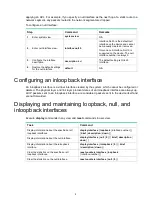
14
LSQM1GT48FD0.
LSQM1TGT24FD0.
•
SA interface module: LSQM2GT48SA0.
•
SC interface modules:
LSQM2GT24PTSSC0.
LSQM2GT24TSSC0.
LSQM4GV48SC0.
LSQM2GT48SC0.
•
For this feature to take effect on an interface, configure the interface to automatically negotiate
a speed or duplex mode with the remote end.
Configuration procedure
To enable EEE on an Ethernet interface:
Step
Command
Remarks
1.
Enter system view.
system-view
N/A
2.
Enter Ethernet interface
view.
interface interface-type
interface-number
N/A
3.
Enable EEE on the
Ethernet interface.
eee enable
By default, EEE is disabled on
an Ethernet interface.
Setting the statistics polling interval
Step
Command
Remarks
1.
Enter system view.
system-view
N/A
2.
Enter Ethernet interface
view.
interface interface-type
interface-number
N/A
3.
Set the statistics polling
interval for the Ethernet
interface.
flow-interval interval
By default, the statistics polling
interval is 300 seconds.
To display the interface statistics collected in the most recent statistics polling interval, use the
display interface
command.
Forcibly bringing up a fiber port
, a fiber port uses separate fibers for transmitting and receiving packets. The
physical state of the fiber port is up only when both transmit and receive fibers are physically
connected. If one of the fibers is disconnected, the fiber port does not work.
To enable a fiber port to forward traffic over a single link, you can use the
port up-mode
command.
This command forcibly brings up a fiber port, even when no fiber links or transceiver modules are
present for the fiber port. When one fiber link is present and up, the fiber port can forward packets
over the link unidirectionally.


























